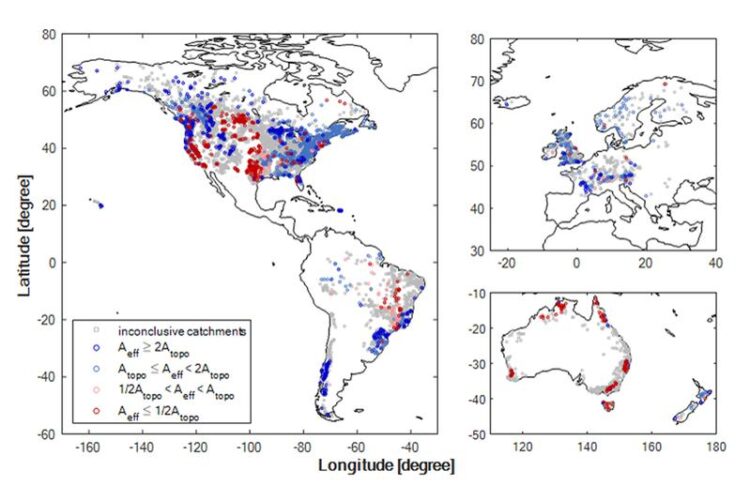Underground connection

Blue circles indicate that the effective catchment area is larger than the topographic catchment area, while red circles illustrate the opposite. The dark blue and dark red circles indicate large deviations.
Credit: Andreas Hartmann
Researchers present first global analysis of how effective and topographic catchment areas differ
Topographically sketched catchment areas are a spatial unit based on the shapes of the earth’s surface. They show how human activities and climate change influence the available quantities of water. Knowledge of these units is fundamental to sustainable water management.
However, due to underground connections, some catchment areas accumulate water from areas beyond their topographic boundaries, while others are effectively much smaller than their surface topography would suggest. Currently, most hydrological modelling strategies do not take these groundwater connections into account, but assume that the catchments are independent of their surroundings.
For this reason, Dr. Yan Liu and Assistant Professor Dr. Andreas Hartmann from the Chair of Hydrological Modeling and Water Resources at the University of Freiburg, together with a team of researchers from the University of Bristol in England and Princeton University in the US, have introduced the Effective Catchment Index (ECI). Using this new metric, they were able to determine how topographic and actual catchment areas differ when analyzing a global data set. The team recently published the results in the journal Environmental Research Letters.
Using the ECI, the team led by Liu and Hartmann was able to demonstrate that the assumption of a closed water balance, i.e. that the level of a river changes only through precipitation and evaporation from its topographic area, for example, does not apply to a considerable number of catchments around the world. Every third catchment studied has an effective catchment area that is even greater than twice or less than half its topographical area. The scientists recognized that these areas influence or are influenced outside their topographical boundaries by water management activities such as pumping groundwater and, for example, deforestation or reforestation.
With their analysis, the researchers show that the ECI they have redefined is suitable for investigating how drought can spread across topographical boundaries as a result of water exchange. It can also be used in the analysis of the effects of climate and land use changes on cross-boundary water exchange. “This is how we have seen where we need to further investigate underground networks across topographical boundaries in order to support sustainable water management,” says Hartmann.
This research is funded by the Emmy-Noether-Program of the German Research Foundation (DFG) within Andreas Hartmann’s project “Global Assessment of Water Stress in Karst Regions in a Changing World.“ The Global Runoff Data Centre (GRDC) provided parts of the flow data for the global catchment area data set.
Original publication:
Liu, Y., Wagener, T., Beck, H.E., Hartmann, A. (2020): What is the hydrologically effective area of a catchment? In: Environmental Research Letters. DOI: 10.1088/1748-9326/aba7e5
https://iopscience.iop.org/article/10.1088/1748-9326/aba7e5
Website of the team
https://www.hydmod.uni-freiburg.de/
Contact:
Dr. Yan Liu and Juniorprofessor Dr. Andreas Hartmann
Chair of Hydrological Modeling and Water Resources
Faculty of Environment and Natural Resources
University of FreiburgTel.: 0761/203-69247 und -3520
E-Mail: yan.liu@hydmod.uni-freiburg.de
andreas.hartmann@hydmod.uni-freiburg.de
https://www.pr.uni-freiburg.de/pm-en/press-releases-2020/underground-connection?set_language=en
Media Contact
All latest news from the category: Earth Sciences
Earth Sciences (also referred to as Geosciences), which deals with basic issues surrounding our planet, plays a vital role in the area of energy and raw materials supply.
Earth Sciences comprises subjects such as geology, geography, geological informatics, paleontology, mineralogy, petrography, crystallography, geophysics, geodesy, glaciology, cartography, photogrammetry, meteorology and seismology, early-warning systems, earthquake research and polar research.
Newest articles

You are What You Eat—Stanford Study Links Fiber to Anti-Cancer Gene Modulation
The Fiber Gap: A Growing Concern in American Diets Fiber is well known to be an important part of a healthy diet, yet less than 10% of Americans eat the minimum recommended…

Trust Your Gut—RNA-Protein Discovery for Better Immunity
HIRI researchers uncover control mechanisms of polysaccharide utilization in Bacteroides thetaiotaomicron. Researchers at the Helmholtz Institute for RNA-based Infection Research (HIRI) and the Julius-Maximilians-Universität (JMU) in Würzburg have identified a…

ASXL1 Mutation: The Hidden Trigger Behind Blood Cancers and Inflammation
Scientists show how a mutated gene harms red and white blood cells. LA JOLLA, CA—Scientists at La Jolla Institute for Immunology (LJI) have discovered how a mutated gene kicks off…



